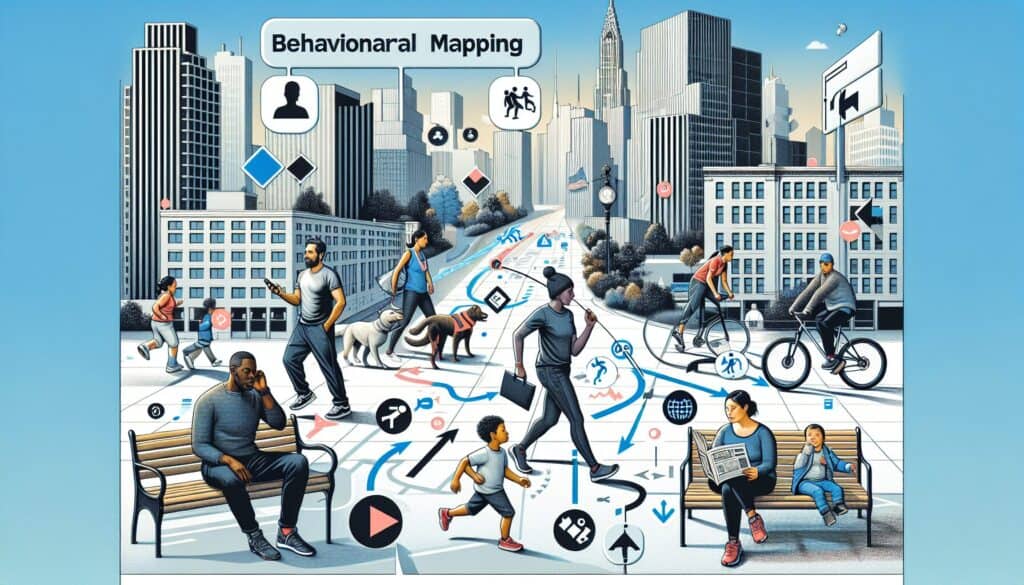To systematically observe and record people’s behaviors and movements within a specific physical space over time to understand how the space is used.
- Metodologie: Clienti e marketing, Ideazione, Progettazione del prodotto
Behavioral Mapping

Behavioral Mapping
- Architettura, Progettazione comportamentale, Progettazione per la sostenibilità, Pensiero progettuale, Human-Centered Design, Usabilità, Test di usabilità, Esperienza utente (UX), Interfaccia utente (UI)
Obiettivo:
Come si usa:
- Researchers create a map of the environment and use symbols or notations to log specific behaviors, paths taken, interactions, and duration of activities at different locations within the space.
Professionisti
- Provides objective data on space utilization and user behavior patterns, helps identify design flaws or opportunities for improvement in physical environments, can inform architectural or interior design decisions.
Contro
- Can be labor-intensive and time-consuming, observer presence might influence behavior (Hawthorne effect), data analysis can be complex depending on the level of detail, ethical considerations regarding observation.
Categorie:
- Clienti e marketing, Ergonomia, Progettazione del prodotto
Ideale per:
- Understanding how people interact with and use physical spaces, such as retail stores, offices, public areas, or healthcare facilities, to optimize design and functionality.
Behavioral mapping is particularly effective in various industries, including retail, urban planning, workplace design, and healthcare, where understanding user behavior can significantly influence design outcomes. For instance, in retail, this methodology allows designers to analyze customer pathways, dwell times, and interaction hotspots within a store, leading companies like Zara or Mela to optimize layouts that enhance customer engagement and increase sales. In urban planning, behavioral mapping can be employed in public spaces to examine how individuals interact with amenities, such as parks or transportation hubs, enabling planners to create environments that encourage social interaction or promote safety. In the context of healthcare facilities, it can highlight how patients navigate through hospitals, providing insights that inform the arrangement of departments to reduce stress and improve operational efficiency. This methodology can be initiated by designers, architects, or behavioral scientists and often involves collaboration with stakeholders, including end-users, to ensure that the mapping accurately captures human behavior. These participants may include focus groups or community members who provide qualitative input that complements the quantitative data collected through observation and logging. Importantly, the objective data generated from behavioral mapping can pinpoint not only areas for improvement but also validate successful design decisions, making it a valuable resource during different project phases, from initial concept development through to post-occupancy evaluation. Analyzing the patterns revealed through behavioral mapping equips teams with the information necessary to create environments that not only meet user needs but also encourage positive interactions and experiences within those spaces.
Fasi chiave di questa metodologia
- Identify specific areas of interest within the environment.
- Select appropriate symbols or notations for behaviors and interactions.
- Determine time intervals for observations.
- Conduct systematic observations in predefined areas.
- Log quantitative data on user interactions and movements.
- Identify patterns and behaviors from the collected data.
- Map the observed behaviors to the spatial layout of the environment.
- Analyze the mapped data to identify areas of concern or opportunity.
- Make design recommendations based on the analysis of user behavior.
Suggerimenti per i professionisti
- Incorporate real-time data collection tools, such as mobile applications or RFID tags, to enhance the accuracy of behavioral mapping.
- Use heat mapping techniques alongside traditional behavioral mapping to visualize high-traffic areas and interaction points more effectively.
- Regularly update and refine your mapping methodology based on ongoing observations and feedback to capture evolving user behaviors.
Leggere e confrontare diverse metodologie, raccomandiamo il
> Ampio archivio di metodologie <
insieme ad altre 400 metodologie.
I vostri commenti su questa metodologia o ulteriori informazioni sono benvenuti su sezione commenti qui sotto ↓ , così come tutte le idee o i link relativi all'ingegneria.
Contesto storico
1986
(se la data non è nota o non è rilevante, ad esempio "meccanica dei fluidi", viene fornita una stima approssimativa della sua notevole comparsa)

Post correlati
Calcolatore da METS a calorie
Meta-analisi
Mappatura dei messaggi
Diagrammi del modello mentale
Forze di spinta e di trazione massime accettabili
Pianificazione dei fabbisogni di materiale (MRP)